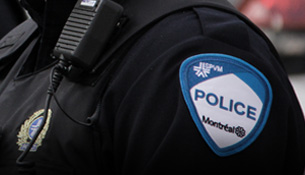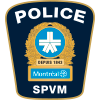History of the police in Montréal
Montréal's first representatives of law and order
On January 27, 1663, Paul Chomedey de Maisonneuve created Montréal's first militia of 120 men. Since the volunteers were more concerned with watching out for enemy threats to the farmers scattered on their lands outside Ville-Marie's walls, suppressing crime or enforcing royal edicts was not their primary responsibility.
Throughout the first century of Montréal's history, there was a succession of various civilian militias. Sometimes peacekeepers, sometimes night watchmen, the militiamen had less time to maintain order when the city was at war, and then occupied after 1763. When the position of peace officer was created in 1787, the office holder, according to the documents of the period, had to “… serve for a year without stipend and subject to a fine of one hundred pounds for premeditated failure to perform”.
As the city grew and commerce prospered, looters appeared, especially at night. To ensure the security of their shops, the merchants demanded the creation of a body of 22 "watchmen". Half town criers, half lamplighters, they patrolled from 7 p.m. to 5 a.m. Armed with a rattle that they shook to alert their colleagues to their presence, they cried the hours and half-hours, shouting "All is well!" into the night. . And that's how Montréal's first real patrolmen earned their French nickname, the bazouelles.
Towards a police department
On June 3, 1843, the City of Montréal was born. On June 15 of the same year, the new municipal council appointed the first police inspector, Alex Comeau. When the city was subdivided into two districts, the function of quartenier was created, precursor of today's neighbourhood police.
But a municipal police force as such did not yet exist. In 1836 a Royal order called on the authorities to " establish an effective police system in the Corporation de Montréal and the Corporation de Québec, and to organize police offices that act under the authority of the civilian secretary of the Governor of theProvince of Lower Canada”.
Thus, a provincial police force was created first to look after Lower Canada's metropolis. In 1849, these 122 men armed with muskets faced the burning of the Union Parliament. Martial law was imposed once again and public safety was put in the hands of the military authorities.
On May 10, 1865, the service changed name to the "Montréal Police Department". Seven police chiefs succeeded each other since 1843. The Governor of Lower Canada authorized the Montréal Corporation to “arm, clothe, house and pay” its police officers and agents.
The City hired " robust and capable constables who are armed at the discretion of the police committee with rifles or light muskets, bayonets and revolvers or any other weapon that the police committee might select, which they are to use only in cases of extreme need”. To keep pace with the growth of the City's population, the Montréal Police had to hire "casual" constables, who would serve for three-month periods.
Between 1903 and 1913, the population expanded continuously. New communities gradually were born in the suburbs. The size of the police force kept pace with this expansion, and the number of police officers rose from 467 to 890. Seeking to extend its territory and make its services viable, Montréal doubled its territory between 1908 and 1918, by annexing municipalities and territories. In 1918, the City of Montréal had a population of 606,000 souls, and 33 police stations.
Expansion and modernization
In April 1909, the municipal administration faced the first Royal Commission of Inquiry in its history. All the city's departments then required a reorganization, which would be entrusted to a Board of Commissioners. A new Public Security Department addressed the modernization of the municipal police, in particular. The police no longer were limited to patrolling and "chasing thieves". A Morality Squad in 1909, police cars and the first ambulance in 1914, new "Murder", "Armed Robbery" and "Major Offences" sections, a Narcotics Squad, bulletproof vests for detectives: police services were increasingly specialized and better equipped.
In the interwar period, the establishment of a major modern police service was completed in Montréal with the launch of the "Montréal Police Radio", the creation of an "antisubversive" squad, the establishment of a tactical squad and the creation of a Traffic Section equipped with motorcycles. In 1947, twenty women were hired and assigned to the new Juvenile Morality Squad. These women would stay with the Police Department, contrary to the four women hired in 1918, who were laid off a few months later. In the 1960s, when Montréal and the suburbs were served by about 5000 police officers, and until the Montréal Police Department and the other police departments gave way to the Service de police de la Communauté urbaine de Montréal (SPCUM), discussions continued about the merger of police forces for the entire Island.
One Island-wide police service
On January 1 1972, the Service de police de la Communauté urbaine de Montréal was born, integrating the police forces of the Island of Montréal into one organization. This was the beginning of the story for the 5239 police officers, 595 civilian employees and 459 school crossing guards distributed through the 39 districts of the Communauté urbaine de Montréal. A quarter of a century later, this history would lead them to record a motto on the police insignia, which is also a mission statement: "Ensemble pour mieux servir" (Together to serve you better).
In 1995, the SPCUM adopted its new police model, Neighbourhood Policing. With the aim of better countering emerging safety problems, this model seeks to strengthen community ties through an approach based on solving problems, building partnerships and on a greater openness toward community groups. In 1996 and 1997, the 24 police districts of Montréal became 49 neighbourhood police stations (PDQ), which then were consolidated gradually over the years into 29 neighbourhood police stations.
On January 1, 2002, the Service de police de la Communauté urbaine de Montréal (SPCUM) became the Service de police de la Ville de Montréal (SPVM).
Find out more



